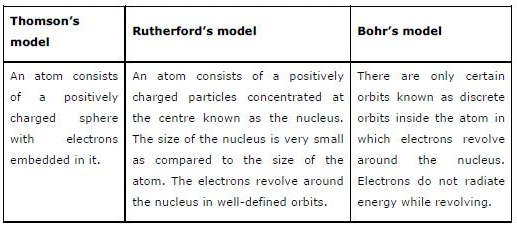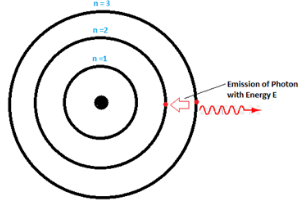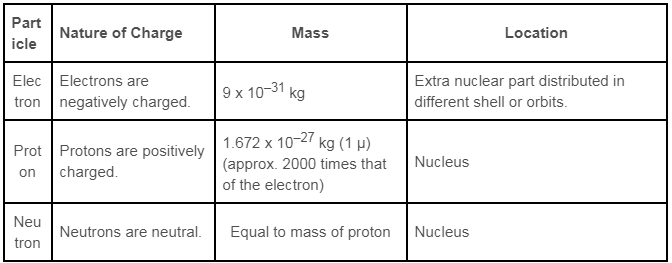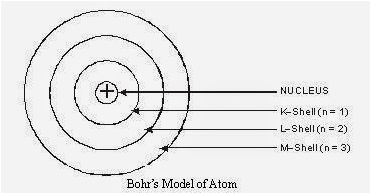NCERT Solution Class 9th Science Ch 4: Structure Of The Atom, NCERT Solutions for Class 9 Science (Chemistry) Chapter 4 – Structure Of The Atom solved by Expert Teachers as per NCERT (CBSE) Book guidelines. These solutions are part of NCERT Solutions for Class 9 Science. Here we have given Class 9 NCERT Science Textbook Solutions for Chapter 4 Structure Of The Atom.
NCERT
Solution Class
9th Science Ch 4:
Structure Of The Atom
1: What are the canal rays?
Answer: Canal rays are positively charged radiations. These rays consist of positively charged particles known as protons. They were discovered by Gold stein in 1886.
2: If an atom contains one electron and one proton, will it carry any charge or not?
Answer: An electron is a negatively charged particle, whereas a proton is a positively charged particle. The magnitude of their charges is equal. Therefore, an atom containing one electron and one proton will not carry any charge. Thus, it will be a neutral atom.
NCERT Solution Class 9th Science Ch 4: Structure Of The Atom
See Also: NCERT Solutions for Class 9 Science
1: On the basis of Thomson’s model of an atom, explain how the atom is neutral as a whole.
Answer: According to Thomson’s model of the atom, an atom consists of both negatively and positively charged particles. The negatively charged particles are embedded in the positively charged sphere. These negative and positive charges are equal in magnitude. Thus, by counterbalancing each other’s effect, they make an atom neutral.
2: On the basis of Rutherford’s model of an atom, which subatomic particle is present in the nucleus of an atom?
Answer: On the basis of Rutherford’s model of an atom, protons (positively-charged particles) are present in the nucleus of an atom.
3: Draw a sketch of Bohr’s model of an atom with three shells.
Answer :
4: What do you think would be the observation if the α-particle scattering experiment is carried out using a foil of a metal other than gold?
Answer: If the α-scattering experiment is carried out using a foil of metal rather than gold, there would be no change in the observation. In the α-scattering experiment, a gold foil was taken because gold is malleable and a thin foil of gold can be easily made. It is difficult to make such foils from other metals.
NCERT Solution Class 9th Science Ch 4: Structure Of The Atom
See Also: NCERT Solutions for Class 9th: Ch 4 Structure of the Atom
1: Name the three sub-atomic particles of an atom.
Answer: The three sub-atomic particles of an atom are:
(i) Protons
(ii) Electrons, and
(iii) Neutrons
2: Helium atom has an atomic mass of 4 u and two protons in its nucleus. How many neutrons does it have?
Answer: Helium atom has two neutrons. The mass of an atom is the sum of the masses of protons and neutrons present in its nucleus.
Since helium atom has two protons, mass contributed by the two protons is (2 × 1) u = 2 u.
Then, the remaining mass (4 − 2) u = 2 u is contributed by 2u /1u = 2 neutrons.
1: Write the distribution of electrons in carbon and sodium atoms?
Answer: The total number of electrons in a carbon atom is 6. The distribution of electrons in carbon atom is given by:
First orbit or K-shell = 2 electrons
Second orbit or L-shell = 4 electrons
Or,
we can write the distribution of electrons in a carbon atom as 2, 4.
The total number of electrons in a sodium atom is 11. The distribution of electrons in sodium atom is given by:
First orbit or K-shell = 2 electrons
Second orbit or L-shell = 8 electrons
Third orbit or M-shell = 1 electron
Or,
we can write distribution of electrons in a sodium atom as 2, 8, 1.
2: If K and L shells of an atom are full, then what would be the total number of electrons in the atom?
Answer: The maximum number of electrons that can occupy K and L-shells of an atom are 2 and 8 respectively. Therefore, if K and L-shells of an atom are full, then the total number of electrons in the atom would be (2 + 8) = 10 electrons.
NCERT Solution Class 9th Science Ch 4: Structure Of The Atom
See Also: NCERT Solution Class 9th Science Chapter 2: Is Matter Around Us Pure
1: How will you find the valency of chlorine, sulfur, and magnesium?
Answer: If the number of electrons in the outermost shell of the atom of an element is less than or equal to 4, then the valency of the element is equal to the number of electrons in the outermost shell.
On the other hand, if the number of electrons in the outermost shell of the atom of an element is greater than 4, then the valency of that element is determined by subtracting the number of electrons in the outermost shell from 8.
The distribution of electrons in chlorine, sulfur, and magnesium atoms are 2, 8, 7; 2, 8, 6 and 2, 8, 2 respectively. Therefore, the number of electrons in the outermost shell of chlorine, sulfur, and magnesium atoms are 7, 6, and 2 respectively.
Thus,
The valency of chlorine = 8 −7 = 1
The valency of sulphur = 8 − 6 = 2
The valency of magnesium = 2
1: If the number of electrons in an atom is 8 and the number of protons is also 8, then
(i) what is the atomic number of the atom and
Answer: The atomic number is equal to the number of protons. Therefore, the atomic number of the atom is 8.
(ii) what is the charge on the atom?
Answer: Since the number of both electrons and protons is equal, therefore, the charge on the atom is 0.
2: With the help of Table 4.1, find out the mass number of oxygen and sulfur atom.
Answer: Mass number of oxygen = Number of protons + Number of neutrons
= 8 + 8
= 16
The mass number of sulfur = Number of protons + Number of neutrons
= 16 +16
= 32
NCERT Solution Class 9th Science Ch 4: Structure Of The Atom
See Also: NCERT Beehive English Solution Class 9th Chapter 1: The Fun They Had
1: For the symbol H, D, and T tabulate three subatomic particles found each of them.
Answer:
2: Write the electronic configuration of any pair of isotopes and isobars.
Answer: Two isotopes of carbon are
C612 and C614 The electronic configuration of C612 is 2,4. The electronic configuration of C614 is 2, 4. [Isotopes have the same electronic configuration] Ca2940 and Ar1840 are a pair of isobars The electronic configuration of Ca2940 is 2, 8, 8, 2 The electronic configuration of A1840 is 2, 8, 8. [Isobars have different electronic configuration]
NCERT Solution Class 9th Science Ch 4: Structure Of The Atom
[table id=1 /]
Exercises
1: Compare the properties of electrons, protons, and neutrons.
Answer:
2: What are the limitations of J.J. Thomson’s model of the atom?
Answer: According to J.J. Thomson’s model of an atom, an atom consists of a positively charged sphere with electrons embedded in it. However, it was later found that the positively charged particles reside at the center of the atom called the nucleus, and the electrons revolve around the nucleus.
3: What are the limitations of Rutherford’s model of the atom?
Answer: According to Rutherford’s model of an atom, electrons revolve around the nucleus in fixed orbits. But, an electron revolving in circular orbits will not be stable because, during the revolution, it will experience acceleration. Due to acceleration, the electrons will lose energy in the form of radiation and fall into the nucleus. In such a case, the atom would be highly unstable and collapse.
4: Describe Bohr’s model of the atom.
Answer: Bohr’s model of the atom Niels Bohr proposed the following postulates regarding the model of the atom.
(i) Only certain orbits known as discrete orbits of electrons are allowed inside the atom.
(ii) While revolving in these discrete orbits, the electrons do not radiate energy. These discrete orbits or shells are shown in the following diagram.
The first orbit (i.e., for n = 1) is represented by letter K. Similarly, for n = 2, it is L − shell, for n = 3, it is
M − shell and for n = 4, it is N − shell. These orbits or shells are also called energy levels.
NCERT Solution Class 9th Science Ch 4: Structure Of The Atom
5: Compare all the proposed models of an atom given in this chapter.
Answer:

6: Summarize the rules for the writing of the distribution of electrons in various shells for the first eighteen elements.
Answer: The rules for the writing of the distribution of electrons in various shells for the first eighteen elements are given below:
(i) The maximum number of electrons that a shell can accommodate is given by the formula ‘
2n2
‘, where ‘n’ is the orbit number or energy level index (n = 1, 2, 3…).
The maximum number of electrons present in an orbit of n = 1 given by
2n2
= 2 × 1 = 2
Similarly, for second orbit, it is 2n2= 2 × 22 = 8 For third orbit, it is 2n2 = 2 × 32= 18
And so on …..
(ii) The outermost orbit can be accommodated by a maximum number of 8 electrons.
(iii) Shells are filled with electrons in a stepwise manner i.e., the outer shell is not occupied with electrons unless the inner shells are completely filled with electrons.
NCERT Solution Class 9th Science Ch 4: Structure Of The Atom
7: Define valency by taking examples of silicon and oxygen.
Answer: The valency of an element is the combining capacity of that element. The valency of an element is determined by the number of valence electrons present in the atom of that element. If the number of valence electrons of the atom of an element is less than or equal to four, then the valency of that element is equal to the number of valence electrons. For example, the atom of silicon has four valence electrons.
Thus, the valency of silicon is four. On the other hand, if the number of valence electrons of the atom of an element is greater than four, then the valency of that element is obtained by subtracting the number of valence electrons from eight. For example, the atom of oxygen has six valence electrons.
Thus, the valency of oxygen is (8 − 6) i.e., two.
8: Explain with examples
(i) Atomic number,
Answer: Atomic number
The atomic number of an element is the total number of protons present in the atom of that element.
For example, nitrogen has 7 protons in its atom. Thus, the atomic number of nitrogen is 7.
(ii) Mass number,
Answer: Mass number
The mass number of an element is the sum of the number of protons and neutrons present in the atom of that element. For example, the atom of boron has 5 protons and 6 neutrons. So, the mass number of boron is 5 + 6 = 11.
(iii) Isotopes
Answer: Isotopes
They are atoms of the same element and have the same atomic number but the different mass numbers/atomic mass. For example:
Carbon:
C612 and C614
(iv) Isobars.
Answer: Isobars
They are atoms of different elements having the same mass number but a different atomic number.
For example calcium, atomic number 20 and argon, atomic number 18.
The number of electrons in these atoms is different, but the mass number of both these elements is 40. That is, the total number of neutrons is the same in the atoms of this pair of elements.
Two uses of isotopes are as follows:
(i) An isotope of uranium is used as fuel in nuclear reactors.
(ii) An isotope of cobalt is used in the treatment of cancer.
9: Na+ has completely filled K and L shells. Explain.
Answer: Na has atomic number 11, so its electronic configuration is = 2, 8, 1
When it gives away its outermost shell single electron it changes to Na+ =10= 2, 8
The above configuration indicates completely filled K, L shells.
NCERT Solution Class 9th Science Ch 4: Structure Of The Atom
10: If bromine atom is available in the form of, say, two isotopes
Br3579 (49.7%) and Br3581 (50.3%),
calculate the average atomic mass of bromine atom.
Answer: The average atomic mass of bromine
= (79 x 49.7)+ (81 x 50.3)/100
= (3926.3 + 4074.3)/100
= 8000.6/100
= 80 u
11: The average atomic mass of a sample of an element X is 16.2 u. What are the percentages of isotopes
X816 and X818
in the sample?
Answer: Since average atomic mass
= 16 x X + 18 x (100 – X )/100
16.2 = 16X + 1800 – 18X/100
1620 = – 2X + 1800
2X = 1800 – 1620
X = 180/2 = 90
When 90% is the X-16 sample so for X-18 sample % = 100-90=10%
12: If Z = 3, what would be the valency of the element? Also, name the element.
Answer: By Z = 3, we mean that the atomic number of the element is 3. Its electronic configuration is 2, 1.
Hence, the valency of the element is 1 (since the outermost shell has only one electron).
Therefore, the element with Z = 3 is lithium.
13: Composition of the nuclei of two atomic species X and Y are given as under
X Y
Protons = 6 6
Neutrons = 6 8
Give the mass numbers of X and Y. What is the relation between the two species?
Answer: Mass number of X = Number of protons + Number of neutrons
= 6 + 6
= 12
The mass number of Y = Number of protons + Number of neutrons
= 6 + 8
= 14
These two atomic species X and Y have the same atomic number, but different mass numbers.
Hence, they are isotopes.
14: For the following statements, write T for ‘True’ and F for ‘False’.
(a) J.J. Thomson proposed that the nucleus of an atom contains only nucleons.
Answer: J.J. Thomson proposed that the nucleus of an atom contains only nucleons. (F)
(b) A neutron is formed by an electron and a proton combining together. Therefore, it is neutral.
Answer: A neutron is formed by an electron and a proton combining together.
Therefore, it is neutral. (F)
(c) The mass of an electron is about 1/2000 times that of the proton.
Answer: The mass of an electron is about 1/2000 times that of the proton. (T)
(d) An isotope of iodine is used for making tincture iodine, which is used as a medicine.
Answer: An isotope of iodine is used for making tincture iodine, which is used as a medicine. (T)
NCERT Solution Class 9th Science Ch 4: Structure Of The Atom
See Also:
[table id=1 /]
15: Put tick (√ ) against correct choice and cross ( x ) against the wrong choice in the following
question: Rutherford’s alpha-particle scattering experiment was responsible for the discovery of
(a) Atomic nucleus
(b) Electron
(c) Proton
(d) Neutron
Answer: Rutherford’s alpha-particle scattering experiment was responsible for the discovery of
(a) Atomic nucleus (√ )
(b) Electron ( x )
(c) Proton ( x )
(d) Neutron ( x )
16: Put tick ( √ ) against correct choice and cross ( x ) against the wrong choice in the following question: Isotopes of an element have
(a) the same physical properties
(b) different chemical properties
(c) different number of neutrons
(d) different atomic numbers
Answer: Isotopes of an element have
(a) the same physical properties ( x )
(b) different chemical properties ( x )
(c) different number of neutrons (√ )
(d) different atomic numbers ( x )
17: Put a tick (√ ) against correct choice and cross ( x ) against the wrong choice in the following question:
A number of valence electrons in Cl− ion is:
(a) 16
(b) 8
(c) 17
(d) 18
Answer: Number of valence electrons in Cl− ion are:
(a) 16 ( x )
(b) 8 (√ )
(c) 17 ( x )
(d) 18 ( x )
18: Which one of the following is the correct electronic configuration of sodium?
(a) 2, 8
(b) 8, 2, 1
(c) 2, 1, 8
(d) 2, 8, 1
Answer: (d) The correct electronic configuration of sodium is 2, 8, 1.
19: Complete the following table.

Hi, I’m Dev Kirtonia, Founder & CEO of Dev Library. A website that provides all SCERT, NCERT 3 to 12, and BA, B.com, B.Sc, and Computer Science with Post Graduate Notes & Suggestions, Novel, eBooks, Biography, Quotes, Study Materials, and more.








